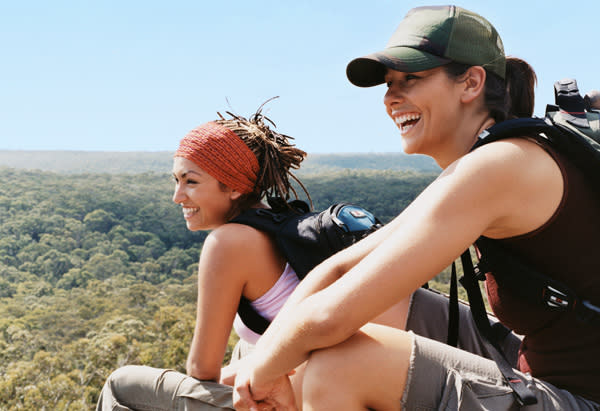4 Ways to Stay Safe When You Hike

Because hiking isn't quite as simple as putting one foot in front of the other, we asked Mandy Pohja, a wilderness instructor with the National Outdoor Leadership School (NOLS), to give us the top mistakes that tend to trip people up.
RELATED: Sign up for Oprah's Lifeclass!
1. Choose the right path.
Pohja sees this time and again. Not only do newbies wander onto trails that are too tough, but people looking for an intense workout accidentally choose an easy amble, get bored and go back to the treadmill at the gym. Hiking trails are usually ranked by difficulty on a scale of 1 to 5, with 1 and 2 presenting low risks of real danger. "In the third class, you might have to use your hands here and there to balance or scramble," says Pohja. "In the fourth class, you're using both hands to pull yourself up, and class 5 is basically rock climbing"-definitely not for beginners. Keep in mind, for a rough guide to your level of effort, you should add about two additional energy miles per every 1,000 feet of elevation gain. So if you're hiking one mile uphill on a mountain taller than 1,000 feet, it will feel like three miles.
RELATED: 7 Steps to Making Better Decisions
2. Pack correctly.
You don't want to end up with 25 pounds of equipment for an easy afternoon hike-and you don't want to be caught empty-handed in an emergency. For a day hike, Pohja's pack always contains these essentials:
A map and a compass. Pohja says that national parks are especially good about keeping their maps up-to-date.
Sunscreen and sunglasses, especially if you're hiking above the tree line. There's less shade, and UV rays are stronger at higher elevations.
Fluids. She recommends 3 to 4 liters of water for each person in your group. "Many people think that they can fill up their bottles in a river, but drinking untreated water can put you at risk for waterborne diseases."
RELATED: Tap Into Your Stream of Consciousness
Snacks. Instead of breaking at the summit for a big lunch, NOLS instructors like to nibble throughout the day. This way, Pohja says, they maintain their energy levels and avoid the discomfort of overeating. She likes snacks that combine carbs for energy as well as protein, like trail mix, jerky, and crackers and peanut butter.
A first aid kit with Band-Aids, athletic tape and an antibiotic ointment to clean wounds.
A rain jacket, regardless of the forecast. "Afternoon thunderstorms are common in the mountains, especially in the West, and a jacket is a small thing that will make a big difference."
A headlamp or flashlight in case you get stuck outside after dark.
RELATED: Pack Like a Pro
3. Consider using hiking poles.
Pohja recently helped lead a group of Naval Academy students on a 30-day wilderness trip in Wyoming. "All of our instructors had poles, and we told the students they could bring them, as well." None of the midshipmen did, and after a few days of picking their way over boulders and down snowy slopes, they were all confessing to pole envy. Poles take some of the weight off your knees, hips and ankles when going downhill; they're highly recommended for hikers with knee or hip issues. Pohja says poles can also help redistribute your weight while walking uphill: "You're engaging more of your upper body and arms." You'll burn more calories this way, which is a benefit if you're going out for a fitness hike.
RELATED: 41 Ways to Have Fun With Your Family in Under 2 Hours
4. Learn to read a map.
Pohja says she has run into strangers in the woods who try to make the map fit the terrain around them. "They think they know where they are," she says, "so they look at the map and say, 'This peak must be that one there; this pile of rocks must be that one over there...' It's easy to convince yourself and others in your group that you know exactly where you are." Your instinct may be to keep forging on optimistically, even if the markers on the map don't match up exactly to what you see in front of you. But be ready to change course. Pohja says, "If the map says you should be hitting a bridge soon, and if you don't hit it in the next 20 to 30 minutes, stop and think about where that bridge might actually be."
RELATED: The Mind Map: 6 Steps to Get Your Creativity Flowing
KEEP READING: For 3 More Mistakes to Avoid When Hiking
More from Oprah.com:
